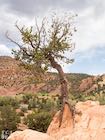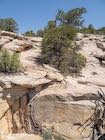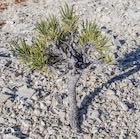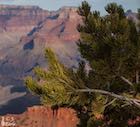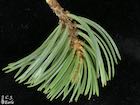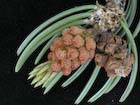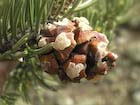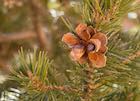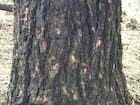Conservation Status

Pinus edulis
Engelm. 1848
Common names
Piñon (Elmore & Janish 1976); New Mexican, Colorado, mesa, two-leaved, or common piñon (or pinyon) pine (Peattie 1950).
Taxonomic notes
Pinus subsection Cembroides. Type not designated. Synonymy:
- Pinus monophylla var. edulis (Engelm.) M.E.Jones 1891;
- Caryopitys edulis (Engelmann) Small 1903;
- Pinus cembroides var. edulis (Engelm.) Voss 1908; and
- Pinus cembroides subsp. edulis (Engelm.) A.E.Murray 1982.
There is one nothospecies, the hybrid with Pinus californiarum, Pinus × kohae Frankis 2024. Type USA, Arizona, Gila County, Tonto National Forest,
Sierra Ancha Experimental Forest, near Natural Drainage D, Sec. 14, T5N, R13E, alt. 4700 ft. [1433 m], 1961.07.04, E. L. Little, Jr. 18581 (holo US, iso A, ARIZ, NY, OKL, TEX, UC, UNM, USFS). Synonymy:
- Pinus edulis var. fallax Little 1968;
- Pinus californiarum subsp. fallax (Little) D.K.Bailey 1987;
- Pinus monophylla var. fallax (Little) Silba 1990;
- Pinus fallax (Little) Businský 2008, non Saporta (1865), fossil name; and
- Pinus monophylla subsp. fallax (Little) Silba 2009.
The hybrid has been found in packrat midden deposits as old as 48,000 years (Cole et al. 2013), indicating at least a Pleistocene origin, possibly older. For more information see the work by Cole et al. (2007) and an interesting blog about that work.
There are also two unnamed natural hybrids, those with P. cembroides (Little 1979) and with P. monophylla. The hybrids with P. monophylla are common where the two species co-occur along the eastern margin of the Great Basin (Lanner 1974).
Also see Pinus cembroides for a general introduction to the phylogenetics of the piñons, a subject that has been greatly clarified by some highly detailed molecular studies; see also Pinus monophylla for further details. The work to identify the hybrid origin of P. × kohae was done mostly by Montes et al. (2022) and Buck et al. (2023). The Montes team tracked multiple molecular lines of evidence in a sampling that included 27 specimens from throughout the range of the Pinus monophylla clade, which includes P. californiarum, P. edulis, P. monophylla, and P. quadrifolia. A number of analyses were ambiguous; two P. × kohae samples grouped with P. edulis and two grouped with P. californiarum. The Buck team used extensive nuclear DNA sequencing from hundreds of samples to characterize core genetic structure for these same species, and then develop estimates of genetic mixing where introgression has occurred. All of the P. × kohae-type samples were dominated by mixing of P. californiarum and P. edulis genes, with no genes unique to P. × kohae; some samples also showing introgression from P. monophylla.
Description
Monoecious evergreen shrubs or trees typically to 21 m tall and 60 cm dbh, strongly tapering, erect; crown conic, rounded, dense. Bark red-brown, shallowly and irregularly furrowed, ridges scaly, rounded. Branches persistent to near trunk base; twigs pale red-brown to tan, rarely glaucous, aging gray-brown to gray, glabrous to papillose-puberulent. Buds ovoid to ellipsoid, red-brown, 0.5-1 cm, resinous. Leaves 1-2(-3) per fascicle, upcurved, persisting 4-6 years, 20-40 × (0.9-)1-1.5 mm, connivent, 2-sided (1-leaved fascicles with leaves 2-grooved, 3-leaved fascicles with leaves 3-sided), blue-green, all surfaces marked with pale stomatal bands, particularly the adaxial, margins entire or finely serrulate, apex narrowly acute to subulate; sheath 0.5-0.7 cm, scales soon recurved, forming rosette, shed early. Pollen cones ellipsoid, ca. 7 mm, yellowish to red-brown. Seed cones maturing in 2 years, shedding seeds and falling soon thereafter, spreading, symmetric, ovoid before opening, depressed-ovoid to nearly globose when open, ca. (3.5)4(-5) cm, pale yellow- to pale red-brown, resinous, nearly sessile to short-stalked; apophyses thickened, raised, angulate; umbo subcentral, slightly raised or depressed, truncate or umbilicate. As with other piñons, the seeds rest in a deep cone-scale declivity and upper cone scale tissue holds the seeds in place, so seeds do not readily fall out and are readily available to avian dispersers. Seeds mostly ellipsoid to obovoid; body 10-15 mm, brown, wingless. 2 n=24 (Kral 1993, Ronald M. Lanner e-mail 1999.12.20).
If the tree bears predominately 2-needled fascicles, it is var. edulis. Identification of P. × kohae is most easily done by geography; as shown below, this variety is the only piñon in most of its range that bears predominately 1-needled fascicles. The broad zone of transition between pure P. edulis and P. × kohae is marked by trees with a mixture of 1- and 2-needled fascicles; as detailed by Cole et al. (2008), the transition from multiple to single needles in a fascicle is highly correlated with exposure to very dry climate. In areas where P. californiarum or P. monophylla may also occur, see P. monophylla for discussion of how to distinguish the different 1-needle piñons, and a discussion of how genetic mixing affects identification of these taxa in the field.
Distribution and Ecology
USA: widespread in Arizona, Utah, Colorado, and New Mexico, with small outlier populations in extreme eastern Nevada, southern Wyoming, extreme western Oklahoma, trans-Pecos Texas, and Mexico: Chihuahua. Grows at elevations of 1500-2100(-2700) m. Found on dry mountain slopes, mesas, and plateaus (Kral 1993). Little (1968) asserts that P. × kohae generally occurs at lower elevations than P. edulis; elevations of the samples mapped below range from 793-1620 m, with a mean of 1386 m. The IUCN classifies this species as "Least Concern" for human impacts due to the extremely large extent of occurrence. The IUCN does not recognize P. × kohae, but according to their listing criteria, it also would be "Least Concern", for the same reason.
Distribution map. Purple represents P. edulis, blue is P. × kohae, red is P. californiarum, green is P. monophylla, and orange is P. quadrifolia. Pinus californiarum, P. × kohae, and P. monophylla polygons by Cole (2003), based on a climate-calibrated habitat model. P. edulis and P. quadrifolia polygons by USGS (1999), based on professional judgement by E. L. Little. All point data from GBIF, DOIs = https://doi.org/10.15468/dl.7acmds (P. × kohae), https://doi.org/10.15468/dl.twthv7 (P. californiarum), https://doi.org/10.15468/dl.5unbjc (P. monophylla), and https://doi.org/10.15468/dl.qugjbg (P. quadrifolia); all accessed 2023.03.11. GBIF data processed to add coordinates based on narrative descriptions, and remove duplicates.
This is one of the principal species of the piñon-juniper (or P-J) woodlands, one of the most widespread forest types of western North America. In the U.S., the conifers include all of the piñons and at least 6 junipers: Juniperus deppeana, J. flaccida, J. monosperma, J. occidentalis, J. osteosperma, and J. scopulorum. Several other, sometimes rather unusual combinations may occur. At the northern extreme, the Missouri Breaks of eastern Montana have Pinus flexilis-Juniperus scopulorum woodlands, whereas Mexico has many more species of both piñon and juniper that combine in numerous ways. Regardless of its dominant tree species composition, the piñon-juniper woodland is of enormous ecological importance because the dominant trees create a structure that produces habitat diversity, attenuates soil erosion and microclimatic extremes, retains snow cover and enhances soil moisture, supports very high diversity of both cryptogamic and vascular vegetation, and provides an important food source (pine nuts and juniper "berries") for many species of birds, mammals, and insects. These resources are in turn available to humans, who historically have exploited them primarily for grazing domestic animals, and in this connection the piñon-juniper woodland is of great economic importance.
P-J woodlands cover an estimate 19 to 40 million hectares in the U.S., and are also very widespread in Mexico (Gottfried et al. 1995, Romme et al. 2009). They share a semiarid climate, shifting to more continuous forest vegetation at the cool/wet limits of their distribution, and giving way from juniper to shrublands or angiosperm woodlands (such as Cercocarpus sp.) at the hot/dry limits. Romme et al. (2009) broadly summarize the ecology of P-J woodlands by assigning them to three groups. The "persistent woodlands" are found where environmental conditions are favorable for P-J conifers; on these sites, fires have always been infrequent. The "P-J savannas" are found where conditions are suitable for both trees and grasses; such sites are subject to low-severity fire, but little is known about their historical dynamics. Finally, the "wooded shrublands" occur where conditions generally support a shrub community, but trees can increase during moist climatic conditions and periods with little disturbance, and will decrease during droughts and after severe disturbance. All three woodland types are vulnerable to dramatic demographic changes due to varied mechanisms such as recovery from past disturbance, livestock grazing, fire suppression, and climate change. It is clear, though, that the historic record, i.e. observations since the mid-19th century, has documented episodes of both extirpation and regeneration of P-J woodlands affecting a landscape scale, sometimes extending to millions of hectares. Examples include very widespread deforestation due to mining activities in Nevada (Young and Budy 1987, Lanner and Frazier 2011), extensive programs of woodland "control" to enhance profits in the livestock industry (Gottfried and Severson 1994), and a drought in the early 2000s (with accompanying pest and disease-caused mortality) that affected 1.2 million hectares of P. edulis-dominated P-J woodlands and killed up to 350 million piñons in the Four Corners region (Shaw et al. 2005, Hicke and Zeppel 2013, Meddens et al. 2015).
Although Americans tend to see P-J woodland as a hot desert vegetation type, Pinus edulis in particular occupies a relatively cold, relatively mesic niche. Annual precipitation varies with geography and elevation from about 250-560(-690) mm, and varies from summer-wet to winter-wet, though some summer rainfall occurs throughout the species' range (Ronco 1990). Pinus edulis tends to give way to junipers or desert shrubs on dry sites, and to forest trees such as Pinus ponderosa on wet sites. Temperatures in the species' range vary from (-35-)4-16(-44)°C, with January means of -10-6°C and July means of 20-27°C (Ronco 1990). Hardy to Zone 5 (cold hardiness limit between -28.8°C and -23.3°C) (Bannister and Neuner 2001).
As noted, Pinus edulis is a major component of the P-J woodland. It is also a minor component of Pinus aristata, Pseudotsuga menziesii var. glauca, Juniperus scopulorum, Pinus ponderosa subsp. scopulorum, Hesperocyparis arizonica, and Quercus spp. forest types. Where they co-occur, common associates are Juniperus monosperma, J. osteosperma, J. erythrocarpa, J. deppeana, and J. scopulorum; these juniper species are ranked roughly from hot-dry to cold-moist site occurrence. Although most stands qualify as "woodland", they still vary considerably in appearance and composition. Dense stands may approach canopy closure with correspondingly low understory species diversity, while very open stands have widely scattered pines and junipers with a diverse assemblage of shrubs, forbs, and grasses. Some of the more common associated species are Quercus gambelii, Q. grisea, Q. turbinella, Cercocarpus montanus, C. ledifolius, Purshia tridentata, Artemisia tridentata, A. nova, Amelanchier spp., Chrysothamnus spp., Cowania mexicana, Fallugia paradoxa, Rhus trilobata, Ephedra spp., Yucca spp., Opuntia spp., Gutierrezia sarothrae, and Eriogonum spp. Some of the more important herbs are Chenopodium graveolens, Solidago pumila, Gilia spp., Penstemon spp., Calochortus nuttallii, Sphaeralcea spp., Aster hirtifolius, Hymenopappus filifolius var. lugens, Oryzopsis hymenoides, Sporobolus spp., Stipa comata, Sitanion hystrix, Koeleria pyramidata, Hilaria jamesii, Bouteloua gracilis, B. curtipendula, Muhlenbergia torreyi, Agropyron smithii, A. spicatum, A. trachycaulum, Bromus tectorum, and Arisitada spp. (Ronco 1990).
Pinus edulis has a singular relationship with the birds that gather, cache and eat their seeds. The trees are completely dependent on these birds for seed dissemination. This relationship is wonderfully detailed in two books by Ron Lanner (Lanner 1981, 1996). Because the seeds are large and wingless, they cannot be disseminated by wind. Instead, the seeds are gathered by corvids, mainly the Clark's nutcracker (Nucifraga columbiana), Steller's jay (Cyanocitta stelleri), and pinyon jay (Gymnorhinus cyanocephalus). Each of these will gather and cache huge numbers of seeds for consumption during the winter months. Some seeds are not recovered by the jays, and germinate to produce new seedlings. Steller's jays collect seed only from open cones, but pinyon jays and Clark's nutcrackers forage from green cones, and then from open cones as the season progresses. Clark's nutcrackers and Steller's jays probably do not effectively disseminate the seeds because their caches are located in ponderosa pine and mixed conifer forests or in the ecotone above P-J woodlands. Pinyon jays, however, cache seeds in woodland areas, and may transport seeds up to 12 kilometers. Thus, the pinyon jay is particularly important to the pine because it forages from both green and mature cones, disseminates the seeds across significant distances, and sites caches in locations where successful regeneration may occur. Pinyon jays can carry an average of up to 56 seeds in an expandable esophagus, and most seeds are cached individually rather than in groups, so there is a good dispersal of the potential seedlings. Pinyon jays live in flocks of 50 to 500 birds, and it has been estimated that during a substantial seed year in New Mexicog, about 4.5 million seeds were cached by a single flock (Ronco 1990). A variety of mammals also use the seeds as a food source, and some, such as the pinyon mouse Peromyscus truei will gather and cache the seeds; but it has not been shown that the mice serve as a dispersal agent (Gumas 2004).
This species, along with Pinus monophylla, is host to the dwarf mistletoe Arceuthobium divaricatum (Hawksworth and Wiens 1996).
Pinus × kohae occurs primarily in the Mogollon Highlands ecoregion of Arizona, and has been dubbed the Mogollon Highlands piñon; it is distinguished ecologically by its greater tolerance of heat and drought stress compared to either of the parent species (about 12 mm less precipitation and 2-4°C higher temperatures), giving it superior adaptation to the shrub-rich P-J habitats of the Mogollon Highlands, and it has thus far escaped widespread depredation by bark beetles (Fleischner et al. 2024). It will be interesting to see how it fares under forecast climate change; it might expand its distribution at the expense of related piñons.
Remarkable Specimens
The largest tree on record had a dbh of 172 cm, height 21 m, crown spread 16 m; it grew in Cuba, New Mexico (American Forests 1996). I presume it has died; as of 2016, the record tree was 133 cm dbh, 16.2 m tall, crown spread 13.7 m, in Santa Fe, New Mexico (American Forests 2023).
The oldest known living specimen, 1115 years old, was documented in a tree-ring chronology covering the period 887-2001 (crossdated after 952), collected in east-central Utah by Stephen T. Gray (doi.org/10.25921/w3j2-0m24). This site was used in a dendroclimatic reconstruction of snowpack variability (Pederson et al. 2011). Trees more than 750 years old are reasonably common, provided that you can find a relatively fireproof site where they have not been killed by ranchers who, especially from the 1950s to the 1990s, would cheerfully bulldoze a thousand-year-old tree in the hope that a little grass would grow up in its stead.
Ethnobotany
The seeds are much eaten and traded by Native Americans (Kral 1993), and by others who are lucky enough to partake of the harvest. The wood was formerly used in construction by Native Americans, and is still often used for fenceposts and firewood. Due to their ecological importance, management of Pinus edulis woodlands is a major concern throughout their area of distribution. Principal management themes include wildfire control, grazing, invasion by weedy forbs and shrubs, and "grassland invasion" due to fire suppression. The literature on this subject is immense; search for "pinyon juniper management" to see some examples.
Pinus edulis has been very widely used since the development of dendrochronology; a recent search found it referenced in 147 papers. In the early 20th century crossdating techniques were used to assign calendar dates to timbers used in the construction of early Native American cliff dwellings and other structures. Later the species was used to develop climate reconstructions, first at the local scale and then as part of large tree-ring data networks covering sub-continental scales. In recent years the uses of the species have further expanded to include streamflow reconstructions, studies of erosion and alluviation, forest demography and succession, forest growth responses to climate change and changing carbon dioxide concentrations, and a host of more esoteric problems in archeology, tree physiology, climate studies, ecology, and geology. More than almost any other tree species, it acts as an articulate witness of all that it experiences in its long lifetime.
Observations
Easily found in most of its range. I have seen it forming vast woodlands in South Park, Colorado (location referenced at right). Some extremely picturesque trees, including some of the oldest known ones, are easily found along the trails and roads of Black Canyon of the Gunnison National Park, also in Colorado. It also appears at Mesa Verde, Grand Canyon, Petrified Forest, Guadalupe Mountains,
Arches, Canyonlands, Capitol Reef, Bryce Canyon, and Zion National Parks.
Remarks
The epithet edulis means "edible", referring to the seeds. Also see the biographical sketch of George Engelmann, who named this species in 1848.
The epithet kohae is from ko', the Hualapai name for pinyon; this nothospecies is the primary pinyon within their traditional lands (Frankis 2024).
Piñon (Pinus edulis) is the state tree of New Mexico (Kral 1993).
Citations
American Forests 1996. The 1996-1997 National Register of Big Trees. Washington, DC: American Forests.
American Forests 2023. 2021 National Register of Champion Trees, accessed 2023.02.22.
Buck, Ryan, Diego Ortega-Del Vecchyo, Catherine Gehring, Rhett Michelson, Dulce Flores-Rentería, Barbara Klein, Amy V. Whipple, and Lluvia Flores-Rentería. 2023. Sequential hybridization may have facilitated ecological transitions in the Southwestern pinyon pine syngameon. New Phytologist 237:2435–49. https://doi.org/10.1111/nph.18543.
Cole, Kenneth. 2003. Map sources for the ranges of one- and two-needled pinyons. http://sbsc.wr.usgs.gov/cprs/research/projects/global_change/RangeMaps/PinyonMapSources.pdf, accessed 2012.04.25, now defunct.
Cole, Kenneth, L., J. F. Fisher, K. Ironside, J. I. Mead, and P. Koehler. 2013. The biogeographic histories of Pinus edulis and Pinus monophylla over the last 50,000 years. Quaternary International 310:96–110.
Engelmann 1848. Sketch of the botany of Dr. Wislizenius' expedition. Appendix, pp. 87-115, to Wislizenus, F. A. Memoir of a Tour to Northern Mexico. Washington.
Frankis, Michael. 2024. An overlooked name and new combinations in Pinus. IDS Yearbook 2023, 43-44.
Fleischner, Thomas L., M. Lisa Floyd, Jessie Rack, David Hanna, Karen Blevins, Bruce Christman, and Andrew T. Holycross. 2024. The Mogollon Highlands Ecoregion of the American Southwest: A Neglected Center of Ecological Diversity. Natural Areas Journal 44(2):104-119. https://doi.org/10.3375/2162-4399-44.2.104.
Gottfried, G. J., and K. E. Severson. 1994. Managing Pinyon-Juniper Woodlands. Rangelands 16(6):234–236.
Gottfried, G. J., T. W. Swetnam, C. D. Allen, J. L. Betancourt, and A. L. Chung-MacCoubrey. 1995. Pinyon-juniper woodlands. Pp. 95-132 in D. M. Finch and J. A. Tainter (eds.), Ecology, diversity and sustainability of the middle Rio Grande basin. General Technical Report RM-GTR-268. Fort Collins, CO: USDA Forest Service Rocky Mountain Forest and Range Experiment Station.
Gumas, J. 2004. Peromyscus truei, Animal Diversity Web https://animaldiversity.org/accounts/Peromyscus_truei/, accessed 2024.12.02.
Hicke, J. A., and Zeppel, M. J. B. 2013. Climate-driven tree mortality: insights from the piñon pine die-off in the United States. New Phytologist 200(2): 301–303. doi:10.1111/nph.12464.
Little, Elbert L. 1968. Two new pinyon varieties from Arizona. Phytologia 17:329–342 (p. 331). Available: Biodiversity Heritage Library, accessed 2023.03.10.
Little, Elbert L., Jr. 1979. Checklist of United States trees (native and naturalized). Agric. Handb. 541. Washington, DC: U.S. Department of Agriculture, Forest Service. 375 p.
Meddens, A. J. H., Hicke, J. A., Macalady, A. K., Buotte, P. C., Cowles, T. R., and Allen, C. D. 2015. Patterns and causes of observed piñon pine mortality in the southwestern United States. New Phytologist 206(1): 91–97. doi:10.1111/nph.13193.
Montes, José Rubén, Pablo Peláez, Ann Willyard, Alejandra Moreno-Letelier, Daniel Piñero, and David S. Gernandt. 2019. Phylogenetics of Pinus subsection Cembroides Engelm. (Pinaceae) inferred from low-copy nuclear gene sequences. Systematic Botany 44(3):501–518. https://doi.org/10.1600/036364419X15620113920563.
Montes, José‐Rubén, Pablo Peláez, Alejandra Moreno‐Letelier, and David S. Gernandt. 2022. Coalescent‐based species delimitation in North American pinyon pines using low‐copy nuclear genes and plastomes. American Journal of Botany 109(5):706–726. https://doi.org/10.1002/ajb2.1847.
Pederson, G. T., S. T. Gray, C. A. Woodhouse, J. L. Betancourt, D. B. Fagre, J. S. Littell, E. Watson, B. H. Luckman, and L. J. Graumlich. 2011.06.09. The unusual nature of recent snowpack declines in the North American Cordillera.
Sciencexpress, DOI: 10.1126/science.1201570
Romme, W. H., C. D. Allen, J. D. Bailey, W. L. Baker, B. T. Bestelmeyer, P. M. Brown, K. S. Eisenhart, M. L.
Floyd, D. W. Huffman, B. F. Jacobs, R. F. Miller, E. H. Muldavin, T. W. Swetnam, R. J. Tausch, and
P. J. Weisberg. 2009. Historical and modern disturbance regimes, stand structures, and landscape
dynamics in piñon-juniper vegetation of the western United States. Rangeland Ecology and
Management 62:203-222.
Ronco, Frank. 1990. Pinyon, in Burns and Honkala (1990).
Shaw, J. D., B. E. Steed, and L. T. DeBlander. 2005. Forest Inventory and Analysis (FIA) annual inventory answers the question: What is happening to pinyon-juniper woodlands? Journal of Forestry: 6:280-285.
Than, C., D. Ruths, and L. Nakhleh. 2008. PhyloNet: A software package for analyzing and reconstructing reticulate evolutionary relationships. BMC Bioinformatics 9: 322.
Young, J. A., and J. D. Budy. 1987. Energy crisis in 19th century Great Basin woodlands. In Proceedings - pinyon-juniper conference; 1986 January 13-16; Reno, NV. Edited by R. L. Everett. U.S. Department of Agriculture, Forest Service, Intermountain Research Station, Ogden, UT. doi:10.2737/INT-GTR-215.
See also
Elwes and Henry 1906-1913 at the Biodiversity Heritage Library. This series of volumes, privately printed, provides some of the most engaging descriptions of conifers ever published. Although they only treat species cultivated in the U.K. and Ireland, and the taxonomy is a bit dated, still these accounts are thorough, treating such topics as species description, range, varieties, exceptionally old or tall specimens, remarkable trees, and cultivation. Despite being over a century old, they are generally accurate, and are illustrated with some remarkable photographs and lithographs.
The FEIS database.
Poulson, A., T. M. Wilson, C. Packer, R. E. Carlson and R. M. Buch. 2020. Essential oils of trunk, limbs, needles and seed cones of Pinus edulis (Pinaceae) from Utah. Phytologia 102(3): 200-207.
Some nice photos at Northern Arizona Flora, accessed 2009.04.28.
Some more nice photos at Wikipedia Commons, accessed 2009.04.28.


